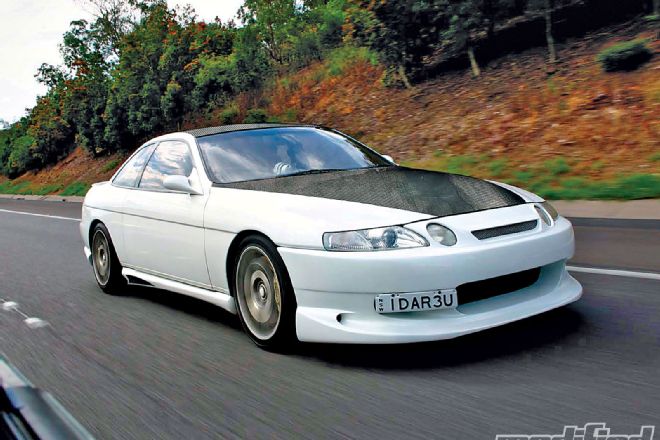There's an old Internet joke you may have come across where people doing 2JZ Toyota engine swaps post a picture of their car with two side-by-side images of the rapper Jay-Z standing in their car's engine bay. I don't know why, but this cracks me up every time I see it. I guess I'm just a sucker for a hip-hop billionaire trying to look all gangstered-out while peeking out of a greasy, old engine bay.
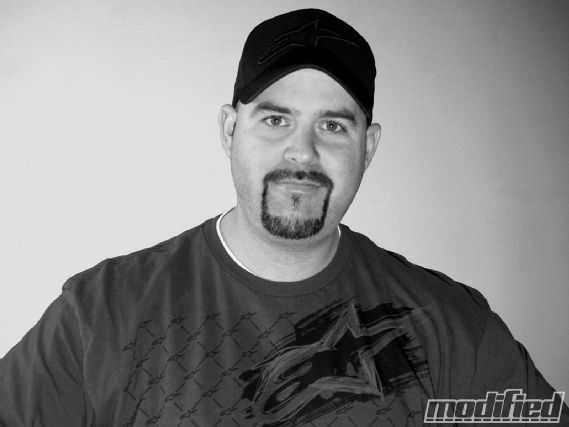 |
Toyota's Lesser-Known JZ Engine - Tech Talk
|
Toyota's Lesser-Known JZ Engine - Tech Talk
Why the fascination with Jay-Z? Lately I've been contemplating buying a JDM right-hand-drive Toyota Soarer as a drift/street car project and in the process have found myself digging up information about the lesser-known 1JZ-GTE twin-turbo engine it's equipped with. In the process, I've found myself wondering something Beyoncé has probably considered: How many Jay-Zs do I really need?
I live in Canada-where it's legal to import JDM cars that are 15 years old or more-so there's no shortage of third-generation (Z30) JDM Toyota Soarers for sale in the $5-7K range. The model to own is the 2.5 GT, because it comes equipped with the 1JZ twin-turbo engine, 5-speed manual transmission and Torsen limited-slip differential. No auto-to-manual transmission swap or normally aspirated non-VVTi 2JZ engine to deal with (like I'd be stuck with if I started with a USDM Lexus SC300), plus some JDM cool factor given the Soarer Griffon emblem and right-hand-drive seating position.
But just how reliable is the 1JZ-GTE (especially one that's 15 years old with an unknown maintenance and repair history), and can it produce the kind of silly tire-shredding horsepower the legendary 2JZ-GTE Toyota Supra TT engine can?
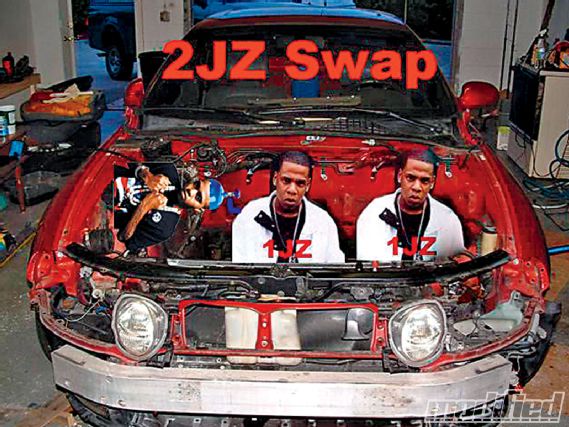 |
This infamous "2JZ Swap" photo has a way of popping up on just about every online discussion of Toyota 2JZ engine swaps.
|
This infamous "2JZ Swap" photo has a way of popping up on just about every online discussion of Toyota 2JZ engine swaps.
The 1JZ-GTE first made its appearance in the Toyota lineup in 1990, designed for longitudinal mounting and rear-wheel drive. A 2.5-liter DOHC inline 6-cylinder that's over-square in design (86mm bore and 71.5mm stroke), this 24-valve 8.5:1 compression ratio engine was first used in the JDM Supra GT, Chaser, Cresta and Mark II and then in the Soarer GT in 1991. With twin CT12A turbochargers arranged in parallel along with a front-mount intercooler, first-generation 1JZ-GTEs pumped out a solid 280 bhp at 6200 rpm and 268 ft-lbs of torque at 4800 rpm. These were some big numbers in the early '90s, especially out of just 2.5 liters of displacement limited to 7500 rpm and 8.5 psi of boost pressure. Most were tied to a slushbox, but the robust Toyota R154 5-speed manual gearbox was available in the Supra GT and Soarer GT.
Perhaps the biggest known weakness of the first- and second-generation 1JZ-GTE is the ceramic turbine wheel used in the CT12A turbochargers. These promote quick spool-up and relatively lag-free acceleration, but at boost levels above 12 to 14 psi they tend to delaminate from the shaft due to the higher impeller speeds and higher operating temperatures that come with running outside their efficiency range.
According to Geoff Raicer from Full-Race, a man whose turbocharger knowledge is Einstein-esque, "The ceramic turbine wheels were used by Toyota because they are ridiculously cheap to manufacture when compared to a legit turbo that uses an inconel turbine wheel that is friction-welded to a 4340 steel shaft. Pulsations from the engine fatigue the ceramic wheel, but ceramic doesn't bend from fatigue, it simply cracks off. This throws everything out of balance and quickly leads to self-destruct mode as the wheel contacts the housing and wipes out the turbocharger's bearings."
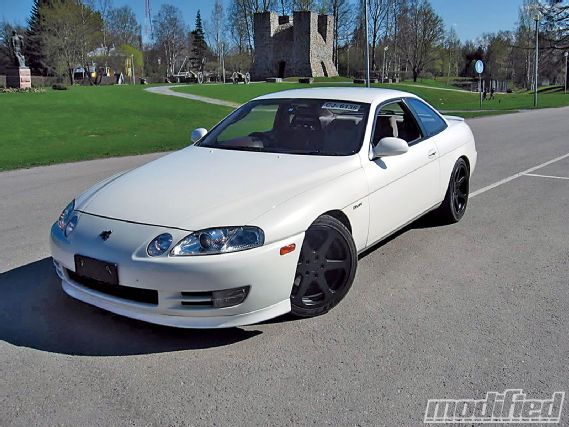 |
The JZZ30 Toyota Soarer 2.5 GT is the model to have, but only 5 percent of them came equipped with a 5-speed manual transmission.
|
The JZZ30 Toyota Soarer 2.5 GT is the model to have, but only 5 percent of them came equipped with a 5-speed manual transmission.
According to Geoff, "I don't really know what I'd consider a safe boost level for the CT12A because the ceramic wheels are so fragile. I just removed them in all the applications I deal with-it's just not worth the risk to shoot turbocharger shards into a perfectly healthy engine."
So for anyone looking to reliably turn up the boost, ditching these fragile old turbos is usually first on the list. In fact, Toyota's own engineers moved away from the CT12A with the third-generation 1JZ-GTE in 1996, instead using a single CT15B. Thanks to the switch to a single-turbo setup (along with the use of a VVTi cylinder head, improved cylinder cooling and a bump in compression ratio to 9.0:1), the third-gen 1JZ-GTE produces 280 ft-lbs of torque at just 2400 rpm, 12 ft-lbs more than the twin-turbo motors at half the rpm. And since these motors often dyno at 270-280 whp in completely stock form, it's safe to say Toyota underrated it quite a bit so that it would fit within the 280-bhp limit all the Japanese carmakers had imposed upon themselves during this era.
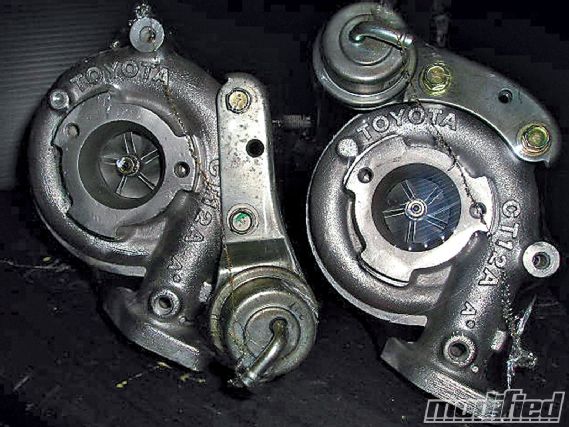 |
Anything beyond 12-14 psi of boost pressure and the stock CT12A turbochargers tend to suffer from ceramic turbine wheel failure due to excessive rpm and heat.
|
Anything beyond 12-14 psi of boost pressure and the stock CT12A turbochargers tend to suffer from ceramic turbine wheel failure due to excessive rpm and heat.
For a single-turbo setup, Geoff from Full-Race recommends going twin-scroll. "A twin-scroll setup is far and away the highest performing setup available, and you can do it on a tight budget using an eBay 1JZ manifold (yeah, I hate those companies too, but the 1JZ is probably the only manifold they make that's functional). With this manifold and a BorgWarner twin-scroll turbo, you've got a phenomenal bang-for-the-buck setup, but keep in mind the divided manifold is critical to lag-free performance."
If you don't have the budget to convert to a single-turbo setup, replacing the CT12A's ceramic wheels with steel turbines is a cost-effective option. This upgrade improves durability at the expense of being heavier and therefore creating more turbo lag, but spool-up can be improved by installing 360-degree bearings and superior balancing during assembly, so in the end you can have CT12As that are more durable than stock yet have a similar spooling rate, along with the ability to turn the boost up to 18-20 psi (although heat generation will continue to be a problem at boost levels above 14 psi).
The 1JZ-GTE engine block is just as legendary in some parts of the world as the 2JZ Supra twin-turbo engine is here, particularly in Australia and Japan where stock-block 1JZs making north of 700 whp are not uncommon. Internally, the 1JZ-GTEs iron block uses ruggedly designed two-bolt main bearing caps and the crankshaft has high nickel content for greater tensile strength. There are oil squirters to cool the underside of the hypereutectic pistons, while the four-valve-per-cylinder head (designed by Yamaha) has excellent flow characteristics, it's only compromise being slightly smaller exhaust-side ports on cylinders 2 and 5.
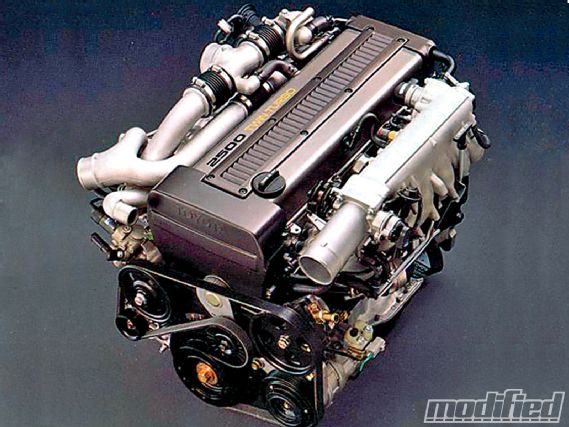 |
Toyota's first- and second-generation 2.5-liter 1JZ-GTE engine used twin parallel-mounted CT12A turbochargers to produce 280 bhp and 268 ft-lbs of torque.
|
Toyota's first- and second-generation 2.5-liter 1JZ-GTE engine used twin parallel-mounted CT12A turbochargers to produce 280 bhp and 268 ft-lbs of torque.
"To reach the 600-700 horsepower level, you're going to need to run race gas or E85 and have a well-sorted turbo setup," Geoff from Full-Race says. "Upgrading the cams, valvesprings and throwing in some light head work will also help. The VVTi cylinder head is also a good option if you want quicker spool-up. To rev the engine beyond the stock redline, you should upgrade rod bolts at least, and the 2JZ oil pump is also an excellent upgrade. I think the 8500-rpm range is the highest I'd ever want to go, but with the short stroke of the 1JZ I'm sure there are guys revving it well beyond 9K."
The Soarer's front-mount intercooler is also a well-known bottleneck, being poorly located in front of the right front wheel where airflow is limited and featuring a fairly inefficient core. Converting to a full-width front-mount intercooler that gets plenty of airflow is key-many Soarer owners use Skyline GT-R cores as an affordable solution (but there are plenty of aftermarket kits as well). The factory ECU has also proven unchippable and unhackable, so given its 14.5-psi boost limit and 180 km/h speed limiter, converting to a piggyback or stand-alone system is a necessity if high horsepower and high speed are among your goals. A'PEXi Power FC, AEM EMS, GReddy eManage and Haltech stand-alone systems are all common approaches among the 1JZ-GTE faithful.
With speed density air metering, an absolutely bulletproof block and compatibility with many 2JZ/Supra bolt-on modifications, it would certainly appear that a JZZ30 Toyota Soarer 2.5 GT has more than enough Jay-Zs under hood if you want to build an affordable drift car. Not only is it a classic-looking Japanese sports coupe, there's ample power potential with the over-square 1JZ-GTE, and the handling side of the equation must also have plenty of potential given the D1GP success of Ueno's T&E/Vertex Soarer. The tough part will be finding one that hasn't been hacked, abused, crashed, resprayed and/or poorly converted from an auto to a manual transmission. | Toyota's Lesser-Known JZ Engine - Tech Talk

